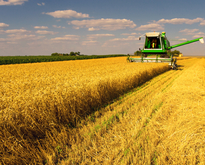In the European Union, over 57 million hectares were used to harvest 301.8 million tonnes of cereals (including rice) in 2016. This represents 590 kilograms of cereal harvested for each EU inhabitant.
Last year, cereal production in the EU decreased by 4.3% compared with 2015 when 315.2 million tonnes were harvested.
Over a longer time period, the production of cereals in the EU has varied between a low of 253 million tonnes in 2003 (a year of severe drought) and a high of more than 332 million tonnes in 2014 (a year with very favorable weather conditions).
Compared with the average over the period 2000-2015, cereal production in the EU was 2.6% higher in 2016, while the area used for cultivation was 7.5% lower.
In terms of value, in 2016, cereals represented 11% of total agricultural output in the EU and accounted for 21% of EU crop production.
The source dataset can be found here.
France remains the largest producer of cereals in the EU
With 54.2 million tonnes harvested on 9.5 million hectares, France remained the largest producer of cereals in the EU, although its production decreased by 25.4% compared with 2015.
France was followed by Germany (45.4 million tonnes of cereals harvested), Poland (29.8 million tonnes), Spain (24.1 million tonnes), the United Kingdom (almost 22 million tonnes), Romania (21.8 million tonnes), Italy (18.2 million tonnes) and Hungary (16.6 million tonnes).
Cereal production globally down in the northern Member States
Cereal production is strongly influenced by weather conditions and 2016 seems to have been favorable for the more central and southern Member States, while unfavorable for the more northern ones.
Compared with 2015, the harvested production of cereals fell in 2016 in the majority of EU Member States. After Cyprus (-88.2%), the largest relative decreases were registered in Estonia (-39.2%), Belgium (-28.9%), France (-25.4%), Luxembourg (-21.1%), the Netherlands (-18.7%), Lithuania (-15.6%), Ireland (-12.3%), the United Kingdom and Sweden (both -11.2%) as well as Latvia (-10.5%).
In contrast, the highest increases were observed in the more central and southern Member States: Slovakia (+27.4%), Croatia (+27.1%), Spain (+19.7%), Hungary (+17.7%), Austria (+17.5%), Italy (+13.0%) and Romania (+12.6%).


